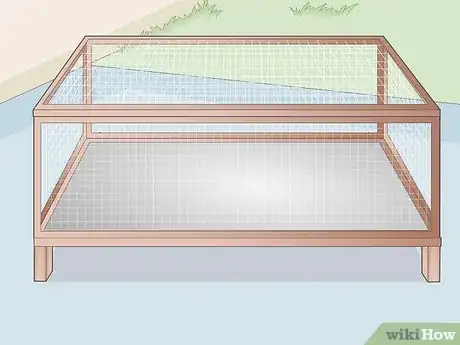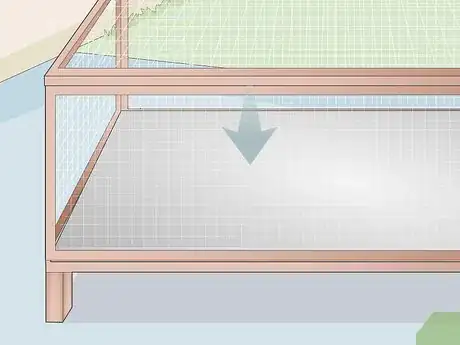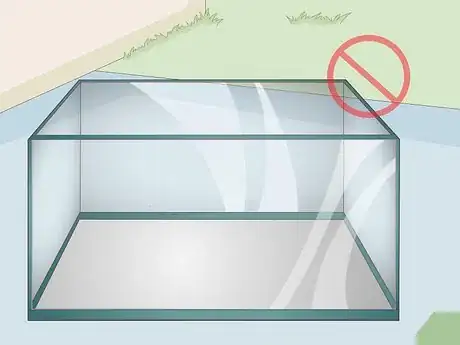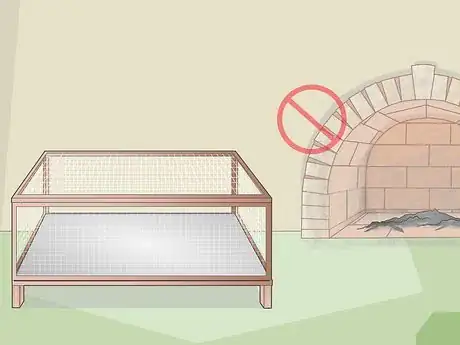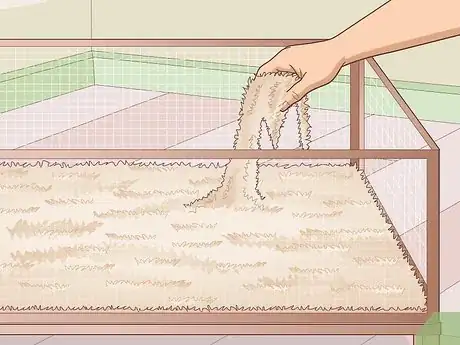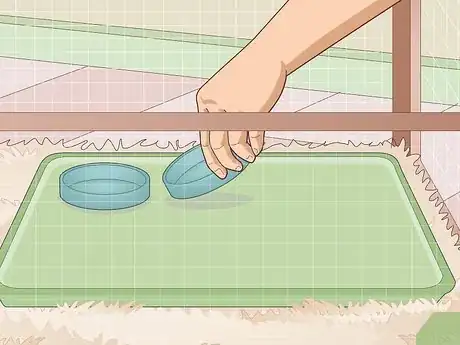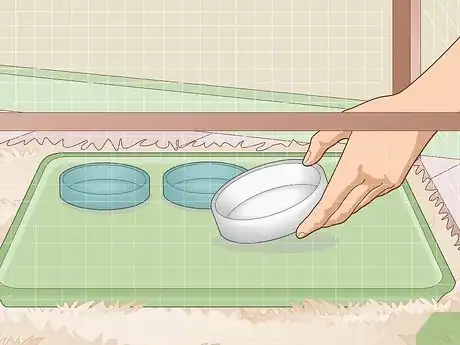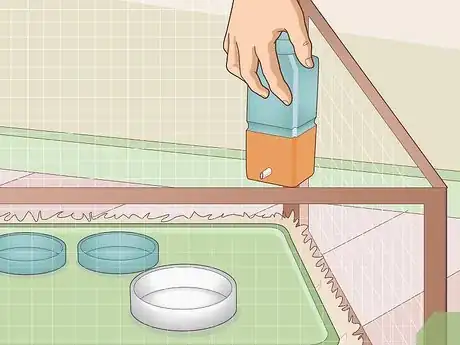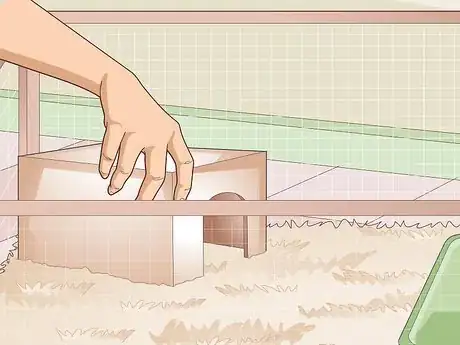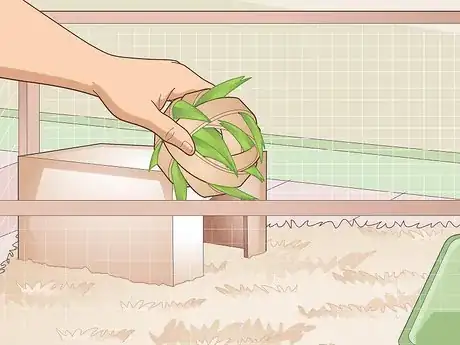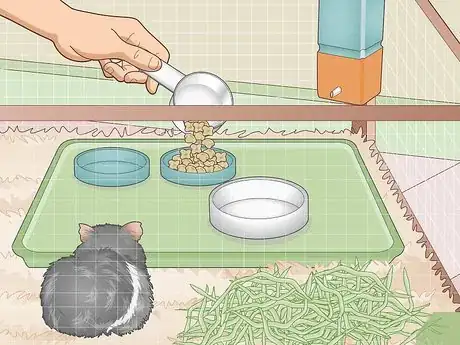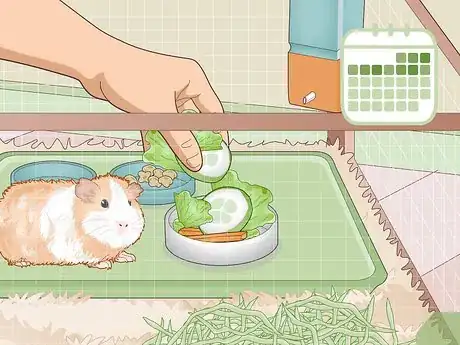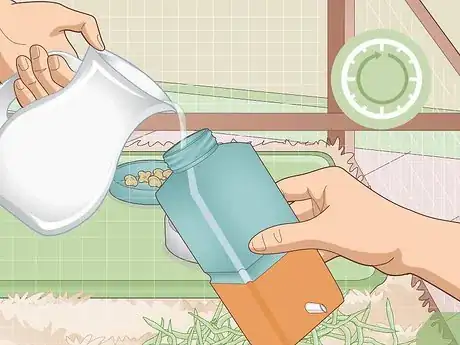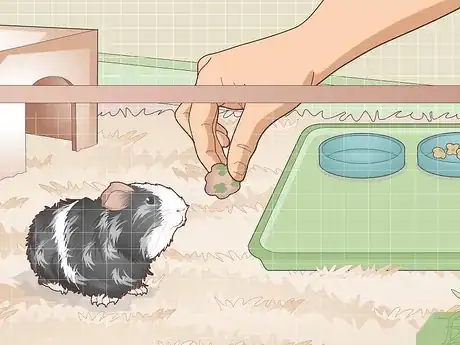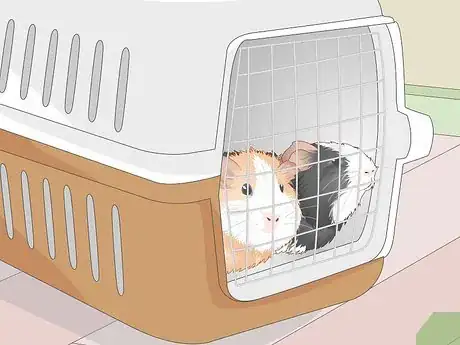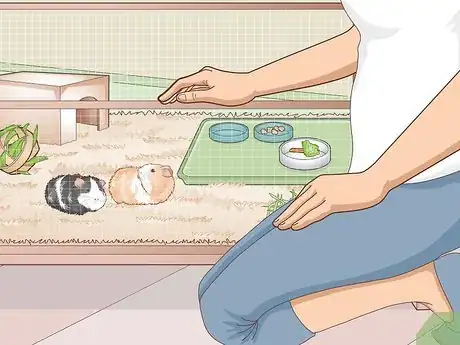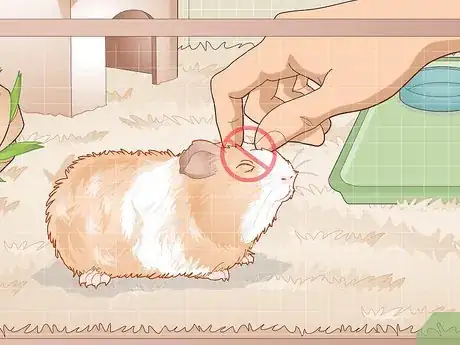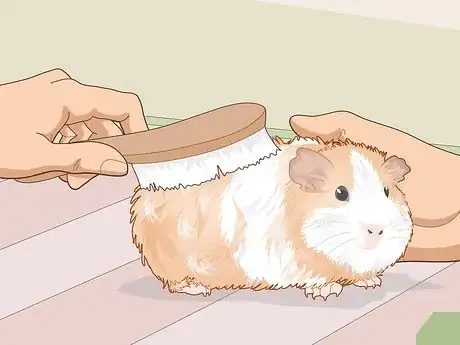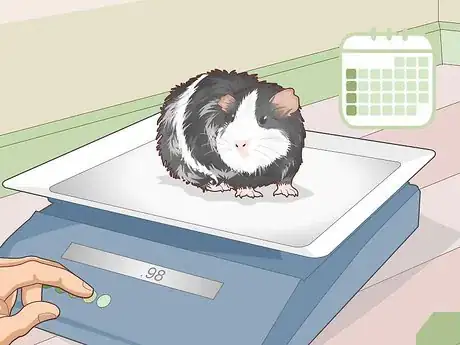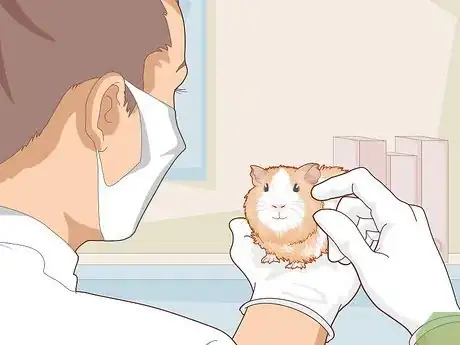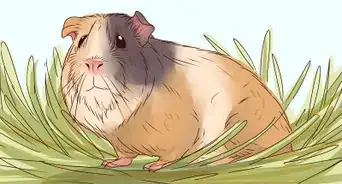wikiHow is a “wiki,” similar to Wikipedia, which means that many of our articles are co-written by multiple authors. To create this article, 10 people, some anonymous, worked to edit and improve it over time.
There are 15 references cited in this article, which can be found at the bottom of the page.
wikiHow marks an article as reader-approved once it receives enough positive feedback. In this case, 95% of readers who voted found the article helpful, earning it our reader-approved status.
This article has been viewed 11,928 times.
Learn more...
Guinea pigs are intelligent and charismatic animals that enjoy human interaction, making them popular first-time pets. While guinea pigs are considered low-maintenance 'pocket' pets, this isn't necessarily true. When cared for properly, guinea pigs can live up to ten years in captivity, and require all-around the clock care and maintenance. In addition to this, guinea pigs are also very expensive; amounting to as high as $100 of expenditure each month and costing several hundreds of dollars in vet fees. To provide your guinea pig with the best care possible, perform some extensive research and continue reading this article below.
Steps
Setting Up Your Guinea Pig's Cage
-
1Purchase a large-sized horizontal cage. The fundamental to a standard cage is to provide plenty of space. The general guidelines for keeping 1-2 guinea pigs is 7.5 square feet of floor space (or 27" by 41"), however, the more space you can provide to your guinea pigs, the happier they will be.[1]
- Small animal cages often utilise vertical space to increase living area and encourage climbing, digging, and burrowing. However, guinea pigs rely on horizontal floor space for enrichment, play, and exercise. Cages with ramps or multiple floors are not suitable for guinea pigs, as guinea pigs do not have flexible backs and aren't good climbers.[2]
- With a roomier enclosure, guinea pigs are less susceptible to developing medical conditions, the likelihood of peaceful co-existence among multiple cavies increases, and your guinea pig is able to exercise on their schedule.[3] [4]
Tip: Cubes and Coroplast (C & C) cages are an easy and inexpensive alternative to commercial cages sold by pet stores. A 2 x 3 C & C cage will fit the minimum of 1-2 guinea pigs.
-
2Choose a cage with a solid base. Guinea pigs have sensitive feet that are susceptible to bumblefoot if kept on wire or mesh flooring. Grid floors should not be used, as they do not allow litter to be provided and can also lead to the development of pressure sores and pododermatitis.[5]Advertisement
-
3Avoid glass tanks or aquariums. While small rodents such as hamsters and mice thrive in glass tanks and aquariums, due to their large size and sensitive respiratory system, guinea pigs do not. This is because glass tanks and aquariums do not provide enough space, aren't well-ventilated, and buffer out noise.[6]
- Aquariums are poorly ventilated and do not have sufficient airflow. This is because they do not have open sides, meaning the only ventilation your guinea pigs will receive would be from the top of the glass tank. Lack of ventilation can trap ammonia in the air, which is secreted through your guinea pig's urine and faeces. This factor can dangerously lead to an upper respiratory infection and other similar health issues.[7]
-
4Place the cage in a suitable location. Guinea pigs are susceptible to noise, temperature, and isolation; therefore, it's suggested by the Humane Society of the United States to keep your guinea pigs indoors. A few factors should be considered when choosing where to place your guinea pig's cage, including;
- Temperature. Guinea pigs prefer a temperature between 65 °F (18 °C) and 75 °F (24 °C). Your guinea pig's cage should be positioned away from strong heat sources, such as direct sunlight, fireplaces, and heating vents. Choose a room that isn't too cold either, such as a draft-free room with central heating during colder months.[8]
- Noise. Guinea pigs have sensitive hearing and do not do well being located near radios, stereos, TV's, or loud animals and children.[9]
- Activity Level. Guinea pigs enjoy the company of their owners. Place your guinea pig's cage in a room where they will receive frequent interaction from the family, such as a living room or bedroom.[10]
-
5Line your guinea pig's cage with absorbent bedding. There are several types of bedding choices to choose from, with wood shavings and fleece being the most popular and commercially available options. With this being said, there are also multiple commercially marketed bedding types for small animals that can harm them. It's important to research the do's and dont's when it comes to purchasing bedding for your guinea pig to find the best material that suits you.
- Aspen or kiln-dried pine wood shavings work well to absorb urine and odour; however, these types of bedding must be cleaned at least once a week to reduce ammonia build-up.[11] Do not purchase cedar shavings, as the phenols (aromatic oils) have been proven to harm guinea pig's health and cause respiratory issues and liver damage.[12] If you are purchasing pine shavings, make sure to look for kiln-dried or dust-extracted pine; otherwise, pine shavings will have the same effect.
- Fleece is another popular option, essentially for indoor C & C cages, because it's soft on their feet and reusable. While fleece is economical and can save on costs, it's also high-maintenance. Fleece requires daily spot-cleaning and needs to be changed every 3-4 days at a minimum. Alternatively, you may need to pair fleece with some additional materials or bedding. Fleece isn't absorbent; rather it allows the urine to soak through.[13]
- Paper bedding, such as CareFresh, is often a preferred alternative to wood shavings, as they are made of a softer material and do not risk dust or phenols being absorbed through the lungs. The disadvantage of paper bedding is, while it has a moderate absorbency, it's often high cost and looks dirty even with the cage just being cleaned.[14]
- Avoid cedar shavings, corn cob bedding, wood pellets, cat litter, straw, and sand.[15] These types of bedding are dangerous, as they can lead to an array of health problems, including URI's and pododermatitis.
-
6Set up a feeding station in their cage. Midwest cages or C & C cages typically have an area to deposit hay, food, and drinking water. This area can double up as a litter tray, as guinea pigs tend to "potty" where they eat. You will likely need to purchase two feeding bowls and a water bottle to set up the feeding area.
-
7Purchase a large shallow food bowl for your guinea pig's vegetables. Opt for a ceramic food dish rather than a plastic one. Ceramic dishes are sturdy, chew-resistant, and difficult to overturn. Your bowl will need to fit one cup of vegetables or two cups if you have two guinea pigs.
- Be mindful of the measurements. You can choose to place all your vegetables in one bowl or purchase separate bowls for each guinea pig.
- Your guinea pig will also need an additional smaller bowl to contain their pellets (1/8 cup per guinea pig).
-
8Choose between a water bottle and a water bowl. While it's advised to use a water bottle for hygiene purposes, some guinea pigs may refuse to drink out of a bottle and find it more natural to drink from a bowl instead.
- With that being said, water bowls can be quite messy and may easily tip. This is particularly true if you use wood shavings, as the shavings can easily be kicked into the bowl.
-
9Provide your guinea pig with a place to hide. Being prey animals, guinea pigs are easily scared and can become overly stressed quickly. Because of this, provide one hiding spot for each guinea pig in your cage to reduce stress levels and make your guinea pig feel comfortable in their home. Plastic igloos, tunnels, lounging logs, and wooden houses are all good hiding spots to place in your guinea pig's cage.
- Because guinea pigs are quite territorial, they need at least one hiding spot per guinea pig and an extra hiding spot to establish a neutral space for the dominant guinea pig to claim.
-
10Add toys to your guinea pig's cage. Guinea pigs come with playful and inquisitive personalities; they love to explore and discover new things. Toys are an important part of your guinea pig's development, as they encourage play and exercise. Hay stuffers, treat balls, tunnels, ramps, hammocks, corner curtains, lounging logs, and chew blocks are a few suitable and safe toys you can buy for your guinea pig.
- While toys are an important part of your guinea pig's cage to provide them with enrichment and mental stimulation, it's important not to overcrowd their cage. If your cage is on the small side, place only a few toys inside and alternate between toys each time you re-arrange or clean the cage.
- Do not purchase exercise wheels or balls. These toys are designed for mice and hamsters but aren't suitable for guinea pigs. Placing your guinea pig inside one of these toys could result in spinal injury.[16]
Feeding Your Guinea Pig a Proper Diet
-
1Provide your guinea pig with unlimited piles of fresh hay. Guinea pigs are herbivores with a strict diet consisting of 80% hay. Hay should be supplied in unlimited, large amounts, scattered around their cage to encourage foraging and play. Hay is an important part of their diet, not only to provide fibre, but to maintain their digestive system, contribute to their dental health, and prevent health issues such as gut stasis.[17]
- Guinea pigs can consume several types of hay, including timothy, orchard, meadow, oaten, and barley hay. Fresh grassy hay that is soft and pliable with a sweet scent and natural green colour is the best variety of hay you can offer to your guinea pig.
- Do not feed your guinea pig straw. While straw is easily mistaken for hay, you can generally detect whether you're buying hay or straw by the consistency and yellow colour. Because of its hard-stemmed texture, straw should not be given to guinea pigs. Straw does not contain enough fibre to sustain your guinea pig's digestive system.
- Do not restrict your guinea pig's hay in racks, balls, hammocks, or pouches. Hay should be placed directly on the floor of their cage in large bundles to encourage healthy eating, foraging, and play. Hay racks are not only dangerous to guinea pigs, as they can trap their heads between the wires, but they discourage your guinea pigs from natural grazing.
- Avoid lucerne, alfalfa, or clover hay. These varieties of hay are too high in calcium and protein to be fed to adult guinea pigs. However, alfalfa can be fed to pregnant or nursing sows and guinea pig pups under 6 months of age.
-
2Choose a high-quality guinea pig pellet. Timothy-hay based pellets should be fed to adult guinea pigs over 6 months of age. Choose a brand that is fortified with vitamin C, as guinea pigs cannot produce vitamin C on their own. Avoid muesli or mixtures that include morsels of dry fruit, grains, or seeds. These types of guinea pig brands encourage selective feeding and aren't healthy for guinea pigs. Choose a plain nugget brand instead.[18] Feed 1/8 cup of pellets per guinea pig each day (1/4 cup for two guinea pigs).[19]
- Do not purchase rabbit and guinea pig food. Rabbits have different dietary needs to that of guinea pigs; therefore, it's unlikely the pellets are fortified with vitamin C or other nutrients your guinea pig needs.[20]
- Steer clear of alfalfa-hay based pellets. While these pellets can be fed to guinea pigs under 6 months of age and pregnant or nursing sows, they are too high in calcium to be fed to adult guinea pigs.[21]
- When purchasing and storing your pellets, purchase the smallest and freshest bag possible. Vitamin C degrades over-time, particularly in warm weather, so it's not advised to purchase your pellets in bulk. Once the vitamin C has degraded, the pellets have no use to guinea pigs. Store your pellets in a dark, dry, and cool area within your home.[22]
-
3Provide your guinea pig with a variety of fresh vegetables daily. Fresh produce such as vegetables, herbs, and leafy greens amount to 15% of your guinea pig's diet. Providing variety is essential to maintaining a well-balanced diet with plenty of nutrients and vitamins.
- Guinea pigs can have a variety of fresh vegetables from cucumber, carrots, spinach, kale, bok choy, asparagus, corn, peas, broccoli, cauliflower, cabbage, tomato, and bell peppers.
- The only vegetable guinea pigs can eat on a daily basis are bell peppers, as they are high in vitamin C, which is essential to your guinea pig's diet. Every other vegetable must be limited 2-4 times a week depending on its nutrient content.
- High calcium vegetables such as kale and spinach should be limited to 1-2 times a week to prevent bladder stones and calcium sludge from forming in older guinea pigs.
- Iceberg lettuce should never be fed to guinea pigs. Most lettuces are too high in water and lack nutrients to be able to be consumed by guinea pigs without health consequences.
-
4Have water readily available at all times. One of the primary elements of caring for your animals is to provide them with unlimited access to fresh and clean water. Refill and clean their water bottle once a day to prevent algae growth and twice a day during the warmer months.
- You can give your guinea pigs water in a bottle or bowl. A water bottle is recommended, as guinea pigs are notorious for tipping their bowls.
-
5Limit the number of treats you feed your guinea pig. While there are many commercial treats marketing towards guinea pigs, a lot of these treats are unhealthy due to high amounts of sugar and fructose.[23] Guinea pigs are most happy with their favourite fruit or vegetable as a treat, rather than store-sold goodies.
- If you do choose to purchase your guinea pigs some treats for a special occasion, pea flakes and baked oxbow treats are a few suitable options. Give only 1-2 treats a day.
- Refrain from purchasing treats with seeds, nuts, grains, or other unhealthy morsels. Most muesli bars are unhealthy. A timothy-hay parsley bowl or bar may be a more suitable option. Any treats with dairy, such as yogurt drops, shouldn't be fed to guinea pigs because they are lactose intolerant.
- Fruits are a healthier alternative to feed to guinea pigs. However, because fruits are also high in sugar, they must be limited to 1-2 times a day.
-
6Refrain from purchasing supplements. Multivitamins and mineral salt wheels are marketed as supplements for your guinea pig's diet and are also advertised as treats for gnawing. If you're feeding your guinea pig a varied and well-balanced diet, these products shouldn't be necessary.[24] If administered in large amounts, guinea pigs can even become ill and develop health defects such as dehydration and bladder issues.[25]
- This applies to multivitamin wheels, salt blocks, pumice stones, and vitamin C drops.
- Vitamin C drops should only be administered if your guinea pig is sick or you've been advised to do so by a well-experienced exotic vet. With a well-balanced diet of fresh vegetables and pellets, your guinea pig should be consuming enough vitamin C on their own. Adding vitamin C supplements to their water or food can discourage your guinea pig from eating or drinking.
Playing with Your Guinea Pig
-
1Adopt more than one guinea pig. Guinea pigs are social animals that naturally live in herds in the wild. It's strongly advised to keep your guinea pig in pairs or small groups of three to prevent social isolation. Guinea pigs begin to show depression-like symptoms if they are housed alone for prolonged periods of time -- although these symptoms may not be as apparent to some.
- Keep male guinea pigs in pairs of two to avoid aggression and territorial dominance. Boars are generally more hostile than sows and are harder to introduce in groups.
- Sows can be kept in groups of three or more, as they are easier to introduce than boars and can co-exist peacefully in a normal-sized cage.
- If you plan on introducing a new cavy to the cage, always adopt a younger guinea pig to that of your current guinea pig. Younger guinea pigs don't pose as much of a risk, as they are smaller and less intimidating.
-
2Spend time with your guinea pig. Guinea pigs like the company of their owners so that they don't feel neglected. Communicate to your guinea pig each time you pass their cage or enter their room.
- Hand-feed your guinea pigs vegetables and fruits when they are most hungry to establish a trusting relationship. Guinea pigs bond better with people they can associate with food since guinea pigs are food-oriented animals.
-
3Refrain from handling your guinea pig until they are comfortable. It's a misconception that most guinea pigs enjoy being held and cuddled. If you jump straight into constantly handling your guinea pig and picking them up, they may become frightened. This is an easy way to break your connection with your guinea pig.
- Once your guinea pig has adjusted to your presence, see if they allow you to stroke or pet them. If your guinea pig doesn't flinch or hide-away, they likely trust you and won't mind you picking them up.
Tip: Always communicate and handle your guinea pig at their eye-level. Guinea pigs are prey animals that become easily frightened if you swoop to hold them from above.
-
4Introduce Your Guinea Pig to Floor Time. Floor time is when you set up a guinea pig proofed space, such as a bedroom or playpen, and give your guinea pigs some time out of their cage to explore. Providing floor time three times a week for at least one hour is recommended; however, daily floor time is ideal.[26]
- The importance of floor time is to allow your guinea pig to exercise and explore in a new environment, promoting mental stimulation and enrichment.
- Place a few obstacles and toys in a guinea pig proofed area, such as tunnels, igloos, ramps, and blocks, and allow your guinea pig to play and explore.
Providing Regular Care for Your Guinea Pig
-
1Spot clean your guinea pig's cage. Spot cleaning refers to cleaning up the soiled patches in your guinea pig's cage by scooping up droppings and replacing with fresh bedding. This should be done daily to keep the cage clean and help the bedding last longer.
-
2Clean your guinea pig's cage thoroughly at least once a week. Guinea pigs frequently urinate throughout the day. The amount of droppings and urine they produce can result in an ammonia build-up, which is unhealthy for their lungs. How often you clean your guinea pig's cage depends on the size of the cage, how many guinea pigs you have, and the type of bedding you use.
- Start by emptying the contents of the cage and putting them aside -- plastic igloos, hammocks, tunnels, ceramic dishes, water bowls, litter tray, etc.
- Empty the bedding into a bin liner using a dust-pan and brush.
- Thoroughly scrub down the base of the cage with a pet-friendly disinfectant, or with three parts water and one part white vinegar. Rinse the base of the cage and grids with warm water and allow to dry.
- Clean and disinfect your guinea pig's toys, water bottle, food bowl, and litter tray with a pet-friendly disinfectant and allow to rinse and dry.
- Line the base of the cage with newspaper or puppy pads and place 2 inches of fresh bedding inside.
- Finish by placing all your guinea pig's items (toys, hides, food bowls) back inside the cage.
-
3Groom your guinea pig at least once a month.[27] In an artificial environment, guinea pig's need to have their nails trimmed at least once a month to prevent over-growth.
- Additionally to this, you should brush your guinea pig's coat at least once a week to minimise shedding. Long-haired breeds, such as Peruvian and Shelties, require regular coat grooming to maintain their long hair.
- Only bathe your guinea pig once or twice a year. Guinea pigs do not need frequent bathing, as they are quite capable of keeping themselves clean. If your guinea pig is smelly, it could be the type of bedding you use. Frequent bathing can cause unintentional stress and irritate your guinea pig's skin.
-
4Weigh your guinea pig weekly. Weight changes are the first symptoms of health issues and illness. By detecting symptoms early, you can potentially save your guinea pig's life. What you should be watching for is dramatic changes in your guinea pig's weight.[28]
- Weigh your guinea pig at the same time each day. Do not alternate between weighing before or after your guinea pig has eaten. Otherwise, this will cause confusion.
- One ounce weight fluctuation is normal, and two ounce weight fluctuation should put you on alert. However, two ounces is not medically serious.[29]
- Three to four ounces of weigh fluctuation is when you need to be on extreme alert and notify a vet. Particularly if you see a pattern of weight loss.[30]
-
5Take your guinea pig for annual checkups. Look for an experienced exotic vet that specialises with guinea pigs. It's advised to take your guinea pig for a regular checkup once a year to keep track of their health.
- Additionally, perform a general examination on a weekly basis at home. Check your guinea pig's fur, skin, eyes, mouth, teeth, nose, feet, and underside.
Community Q&A
-
QuestionCan I keep my guinea pig in an acrylic cage?
 Amy HarrisonTop AnswererUnfortunately, these cages are not made for guinea pigs, but are more suitable for birds. Guinea pigs need open-sided cages with enough ventilation to prevent respiratory infections from occurring. C & C and Midwest cages are some of the cheapest and best designs to adequately house guinea pigs.
Amy HarrisonTop AnswererUnfortunately, these cages are not made for guinea pigs, but are more suitable for birds. Guinea pigs need open-sided cages with enough ventilation to prevent respiratory infections from occurring. C & C and Midwest cages are some of the cheapest and best designs to adequately house guinea pigs. -
QuestionDo I have to take my guinea pigs to the vet?
 Amy HarrisonTop AnswererVeterinary visits are only required when necessary or if you suspect your guinea pig is "off" in terms of their normal behaviour. It is advised to have your guinea pig checked by a vet at least once a year.
Amy HarrisonTop AnswererVeterinary visits are only required when necessary or if you suspect your guinea pig is "off" in terms of their normal behaviour. It is advised to have your guinea pig checked by a vet at least once a year. -
QuestionCan beestings hurt guinea pigs?
 Amy HarrisonTop AnswererYes, and they can be fatal too. Beestings should be treated accordingly by a qualified veterinarian.
Amy HarrisonTop AnswererYes, and they can be fatal too. Beestings should be treated accordingly by a qualified veterinarian.
Warnings
- Be cautious with multi-level cages. Guinea pigs do not possess flexible backs, and can easily hurt themselves if they fall off a ramp at a high level.⧼thumbs_response⧽
- Do not fall into the trap of buying pet store cages that are far too small to house your guinea pig/s.⧼thumbs_response⧽
- Do not feed your guinea pig straw, as it has a tough consistency that is a hazard to guinea pigs.⧼thumbs_response⧽
- Do not use cedar shavings, corn cob bedding, wood pellets, cat litter, straw, or sand.
- Do not purchase exercise wheels or balls for your guinea pigs. These toys are not meant for guinea pigs, and can result in spinal injury.⧼thumbs_response⧽
- Do not purchase a wire hay rack, as guinea pigs can get stuck in them.⧼thumbs_response⧽
- Do not house your guinea pig with other species of animals, such as rabbits, mice, hamsters, or gerbils.⧼thumbs_response⧽
- Do not contain your guinea pigs hay in a small hay rack or container. Guinea pigs prefer large piles of hay added to their cage to encourage normal eating behaviour and foraging.⧼thumbs_response⧽
- Do not house your guinea pig in a glass tank or aquarium, as they do not provide sufficient space or adequate airflow.⧼thumbs_response⧽
- Do not feed your guinea pigs multivitamin wheels, salt blocks, or vitamin drops unless advised by a vet.⧼thumbs_response⧽
- Do not use grids with inner square spaces greater than 3.8cm for your C & C cage.⧼thumbs_response⧽
References
- ↑ https://www.humanesociety.org/resources/guinea-pig-housing
- ↑ https://www.humanesociety.org/resources/guinea-pig-housing
- ↑ https://www.humanesociety.org/resources/guinea-pig-housing
- ↑ http://www.guineapigcages.com/
- ↑ Guinea pigs: Good practice for housing and care. https://science.rspca.org.uk/documents/1494935/9042554/Guinea+pigs+%282011%29+%28PDF+526KB%29.pdf/2956c499-c152-ece0-932d-f6c4c7d33d37?t=1552921885272
- ↑ https://guineapigconnection.typepad.com/pig_notes/2010/11/myth-11-aquarium-tanks-can-be-guinea-pig-cages.html
- ↑ https://guineapigconnection.typepad.com/pig_notes/2010/11/myth-11-aquarium-tanks-can-be-guinea-pig-cages.html
- ↑ https://www.humanesociety.org/resources/guinea-pig-housing
- ↑ https://www.humanesociety.org/resources/guinea-pig-housing
- ↑ https://www.humanesociety.org/resources/guinea-pig-housing
- ↑ https://www.guinealynx.info/bedding_wood.html
- ↑ https://www.guinealynx.info/bedding_avoid.html
- ↑ https://www.guinealynx.info/bedding_fleece.html
- ↑ https://www.guinealynx.info/bedding_paper.html
- ↑ https://www.guinealynx.info/bedding_avoid.html
- ↑ https://squeaksandnibbles.com/can-guinea-pigs-run-in-balls/
- ↑ https://www.humanesociety.org/resources/guinea-pig-feeding
- ↑ https://www.guinealynx.info/pellets.html
- ↑ https://www.humanesociety.org/resources/guinea-pig-feeding
- ↑ https://www.guinealynx.info/pellets.html
- ↑ https://www.guinealynx.info/pellets.html
- ↑ https://www.guinealynx.info/pellets.html
- ↑ https://www.humanesociety.org/resources/guinea-pig-feeding
- ↑ https://www.humanesociety.org/resources/guinea-pig-feeding
- ↑ https://smallpetselect.com/do-guinea-pigs-need-salt-licks/
- ↑ http://www.guineapigtricks.com/guinea-pig-floor-time.html
- ↑ https://www.aspca.org/pet-care/small-pet-care/guinea-pig-care
- ↑ https://www.guinealynx.info/weigh.html
- ↑ https://www.guinealynx.info/weigh.html
- ↑ https://www.guinealynx.info/weigh.html
